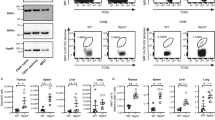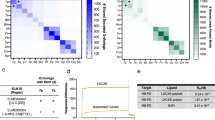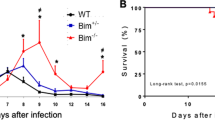Abstract
Theileria parasites infect and transform bovine lymphocytes, but host cell immortalization is reversible, as upon parasite death the lymphocytes rapidly die of apoptosis. Infection leads to a marked augmentation in the levels of lymphocyte c-Myc, and the parasite achieves this by inducing increased c-myc transcription and by prolonging the half-life of the transcription factor. Reduction in c-Myc turnover can be ascribed to CK2-mediated phosphorylation of the transcription factor. A parasite-dependent GM-CSF autocrine loop activates a JAK2/STAT3 signalling pathway that contributes to heightened c-myc transcription, and inhibition of the pathway leads to caspase 9 activation and apoptosis that can be directly ascribed to a reduction in c-Myc. An antiapoptotic role for c-Myc was clearly demonstrated by specific inhibition of c-myc expression with antisense oligonucleotides, and this correlates with loss of the antiapoptotic protein Mcl-1, and, consistently, ectopic expression of c-Myc abrogates B-cell death induced upon JAK2 inhibition. Thus, Theileria parasites ensure the survival of their host lymphocytes via specific activation of c-Myc.
This is a preview of subscription content, access via your institution
Access options
Subscribe to this journal
Receive 50 print issues and online access
$259.00 per year
only $5.18 per issue
Buy this article
- Purchase on Springer Link
- Instant access to full article PDF
Prices may be subject to local taxes which are calculated during checkout







Similar content being viewed by others
References
Albert T, Wells J, Funk JO, Pullner A, Raschke EE, Stelzer G, Meisterernst M, Farnham PJ and Eick D . (2001). J. Biol. Chem., 276, 20482–20490.
Baumgartner M, Angelisova P, Setterblad N, Mooney N, Werling D, Horejsi V and Langsley G . (2003). Blood, 101, 1874–1881.
Baumgartner M, Chaussepied M, Moreau MF, Werling D, Davis WC, Garcia A and Langsley G . (2000). Cell Microbiol., 2, 329–339.
Bowman T, Broome MA, Sinibaldi D, Wharton W, Pledger WJ, Sedivy JM, Irby R, Yeatman T, Courtneidge SA and Jove R . (2001). Proc. Natl. Acad. Sci. USA, 98, 7319–7324.
Catlett-Falcone R, Landowski TH, Oshiro MM, Turkson J, Levitzki A, Savino R, Ciliberto G, Moscinski L, Fernandez-Luna JL, Nunez G, Dalton WS and Jove R . (1999). Immunity, 10, 105–115.
Cavin LG, Romieu-Mourez R, Panta GR, Sun J, Factor VM, Thorgeirsson SS, Sonenshein GE and Arsura M . (2003). Hepatology, 38, 1540–1551.
Channavajhala P and Seldin DC . (2002). Oncogene, 21, 5280–5288.
Chaussepied M and Langsley G . (1996). Res. Immunol., 147, 127–138.
Chaussepied M, Lallemand D, Moreau MF, Adamson R, Hall R and Langsley G . (1998). Mol. Biochem. Parasitol., 94, 215–226.
Chen G and Goeddel DV . (2002). Science, 296, 1634–1635.
Dobbelaere D and Heussler V . (1999). Annu. Rev. Microbiol., 53, 1–42.
Dobbelaere DA, Prospero TD, Roditi IJ, Kelke C, Baumann I, Eichhorn M, Williams RO, Ahmed JS, Baldwin CL, Clevers H and Morrison WI . (1990). Infect Immun., 58, 3847–3855.
Epling-Burnette PK, Liu JH, Catlett-Falcone R, Turkson J, Oshiro M, Kothapalli R, Li Y, Wang JM, Yang-Yen HF, Karras J, Jove R and Loughran Jr TP . (2001). J. Clin. Invest., 107, 351–362.
Evan GI, Wyllie AH, Gilbert CS, Littlewood TD, Land H, Brooks M, Waters CM, Penn LZ and Hancock DC . (1992). Cell, 69, 119–128.
Grumont RJ, Strasser A and Gerondakis S . (2002). Mol. Cell, 10, 1283–1294.
Guergnon J, Chaussepied M, Sopp P, Lizundia R, Moreau MF, Blumen B, Werling D, Howard CJ and Langsley G . (2003a). Cell Microbiol., 5, 709–716.
Guergnon J, Dessauge F, Langsley G and Garcia A . (2003b). Biochimie, 85, 771–776.
Henriksson M, Bakardjiev A, Klein G and Luscher B . (1993). Oncogene, 8, 3199–3209.
Heussler VT, Rottenberg S, Schwab R, Kuenzi P, Fernandez PC, McKellar S, Shiels B, Chen ZJ, Orth K, Wallach D and Dobbelaere DA . (2002). Science, 298, 1033–1036.
Hudson AT, Randall AW, Fry M, Ginger CD, Hill B, Latter VS, McHardy N and Williams RB . (1985). Parasitology, 90 (Part 1), 45–55.
Iavarone C, Catania A, Marinissen MJ, Visconti R, Acunzo M, Tarantino C, Carlomagno MS, Bruni CB, Gutkind JS and Chiariello M . (2003). J. Biol. Chem., 278, 50024–50030.
Kiuchi N, Nakajima K, Ichiba M, Fukada T, Narimatsu M, Mizuno K, Hibi M and Hirano T . (1999). J. Exp. Med., 189, 63–73.
Kuenzi P, Schneider P and Dobbelaere DA . (2003). J. Immunol., 171, 1224–1231.
Leone G, Sears R, Huang E, Rempel R, Nuckolls F, Park CH, Giangrande P, Wu L, Saavedra HI, Field SJ, Thompson MA, Yang H, Fujiwara Y, Greenberg ME, Orkin S, Smith C and Nevins JR . (2001). Mol. Cell, 8, 105–113.
McGuire K, Manuja A, Russell GC, Springbett A, Craigmile SC, Nichani AK, Malhotra DV and Glass EJ . (2004). Vet. Immunol. Immunopathol., 99, 87–98.
McKeever DJ, Nyanjui JK and Ballingall KT . (1997). Parasite Immunol., 19, 319–324.
Meydan N, Grunberger T, Dadi H, Shahar M, Arpaia E, Lapidot Z, Leeder JS, Freedman M, Cohen A, Gazit A, Levitzki A and Roifman CM . (1996). Nature, 379, 645–648.
Moreau MF, Thibaud JL, Miled LB, Chaussepied M, Baumgartner M, Davis WC, Minoprio P and Langsley G . (1999). Infect. Immun., 67, 6678–6682.
Nakajima K, Yamanaka Y, Nakae K, Kojima H, Ichiba M, Kiuchi N, Kitaoka T, Fukada T, Hibi M and Hirano T . (1996). EMBO J., 15, 3651–3658.
Nilsson JA and Cleveland JL . (2003). Oncogene, 22, 9007–9021.
ole-MoiYoi OK, Sugimoto C, Conrad PA and Macklin MD . (1992). Biochemistry, 31, 6193–6202.
Pelengaris S, Khan M and Evan G . (2002). Nat. Rev. Cancer, 2, 764–776.
Saharinen P, Takaluoma K and Silvennoinen O . (2000). Mol. Cell. Biol., 20, 3387–3395.
Seldin DC and Leder P . (1995). Science, 267, 894–897.
Yuste VJ, Sanchez-Lopez I, Sole C, Encinas M, Bayascas JR, Boix J and Comella JX . (2002). J. Neurochem., 80, 126–139.
Zeller KI, Jegga AG, Aronow BJ, O'Donnell KA and Dang CV . (2003). Genome. Biol., 4, R69.
Acknowledgements
We thank Marie Chaussepied, Victor Yuste and Angelita Rebollo for critical reading of the manuscript and helpful comments and Marie-Françoise Moreau for technical assistance. The dominant-negative JAK2 vectors were obtained from Olli Silvennoinen and STAT3 vectors were made by Toshio Hirano and obtained from Iris Behrmann. The c-myc-luciferase and E-box-luciferase plasmids were given by Dirk Eick and Michael Cole, and the CMV-c-Myc plasmid by Gail Sonenshein. FD was supported in part by the Pasteur-Weizmann Foundation, MB by a Swiss National Science Foundation fellowship, SH by a CROUS fellowship from the French Ministère de l'Education Nationale, de l'Enseignement Supérieur et de la Recherche and GL recognizes the support of the CNRS, the Pasteur Institute and the Pasteur-Weizmann Foundation.
Author information
Authors and Affiliations
Corresponding author
Rights and permissions
About this article
Cite this article
Dessauge, F., Hilaly, S., Baumgartner, M. et al. c-Myc activation by Theileria parasites promotes survival of infected B-lymphocytes. Oncogene 24, 1075–1083 (2005). https://doi.org/10.1038/sj.onc.1208314
Received:
Revised:
Accepted:
Published:
Issue Date:
DOI: https://doi.org/10.1038/sj.onc.1208314
Keywords
This article is cited by
-
Theileria annulata SVSP455 interacts with host HSP60
Parasites & Vectors (2022)
-
Trifloxystrobin blocks the growth of Theileria parasites and is a promising drug to treat Buparvaquone resistance
Communications Biology (2022)
-
Theileria parasites subvert E2F signaling to stimulate leukocyte proliferation
Scientific Reports (2020)
-
Curcumin induced oxidative stress causes autophagy and apoptosis in bovine leucocytes transformed by Theileria annulata
Cell Death Discovery (2019)
-
Differentiation therapy and the mechanisms that terminate cancer cell proliferation without harming normal cells
Cell Death & Disease (2018)



